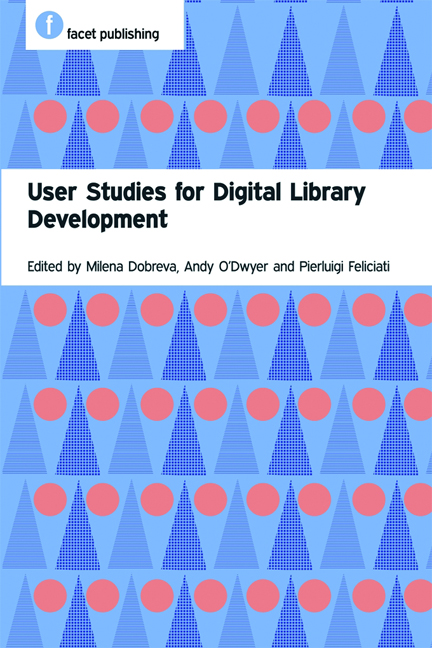Book contents
- Frontmatter
- Contents
- Preface
- Acknowledgements
- Abbreviations
- Glossary
- 1 Introduction: user studies for digital library development
- PART 1 SETTING THE SCENE
- PART 2 METHODS EXPLAINED AND ILLUSTRATED
- PART 3 USER STUDIES IN THE DIGITAL LIBRARY UNIVERSE: WHAT ELSE NEEDS TO BE CONSIDERED?
- PART 4 USER STUDIES ACROSS THE CULTURAL HERITAGE SECTOR
- 18 User studies in libraries
- 19 User studies in archives
- 20 User studies in museums: holding the museum in the palm of your hand
- 21 Digital art online: perspectives on user needs, access, documentation and retrieval
- 22 User studies for digital libraries’ development: audiovisual collections
- 23 A business-model perspective on end-users and open metadata
- PART 5 PUTTING IT ALL TOGETHER
- Index
23 - A business-model perspective on end-users and open metadata
from PART 4 - USER STUDIES ACROSS THE CULTURAL HERITAGE SECTOR
Published online by Cambridge University Press: 08 June 2018
- Frontmatter
- Contents
- Preface
- Acknowledgements
- Abbreviations
- Glossary
- 1 Introduction: user studies for digital library development
- PART 1 SETTING THE SCENE
- PART 2 METHODS EXPLAINED AND ILLUSTRATED
- PART 3 USER STUDIES IN THE DIGITAL LIBRARY UNIVERSE: WHAT ELSE NEEDS TO BE CONSIDERED?
- PART 4 USER STUDIES ACROSS THE CULTURAL HERITAGE SECTOR
- 18 User studies in libraries
- 19 User studies in archives
- 20 User studies in museums: holding the museum in the palm of your hand
- 21 Digital art online: perspectives on user needs, access, documentation and retrieval
- 22 User studies for digital libraries’ development: audiovisual collections
- 23 A business-model perspective on end-users and open metadata
- PART 5 PUTTING IT ALL TOGETHER
- Index
Summary
Introduction
The major European digital library (DL), Europeana, currently holds metadata on 19 million cultural heritage objects that allows for unprecedented resource discovery and links to the actual objects on the sites of 1500 content providers. Metadata in this context refers to the data that describe the key characteristics of the digital content; for instance the name of a work, its creator, date of creation and other background information. Metadata can either be quite simple or extensive and specialized. The cultural institutions that have provided data to Europeana have done so under the conditions specified in the Europeana Data Agreement, first issued in 2009. One of the conditions governing this metadata is that it can be reused for noncommercial purposes only.
Evidence from user research commissioned by Europeana shows that reuse of information consistently comes up as the number one priority for endusers. Work on open metadata is therefore high on the agenda for meeting user expectations and needs, since open metadata is a necessary condition for the reuse of information. To understand better how to combine the wide range of aspirations of Europeana, content providers and endusers, Europeana organized a highlevel brainstorming workshop in July 2011; this chapter summarizes its findings.
We will first introduce the concept of a business model that helps to evaluate the potential for value generation in the case of digital cultural heritage. Then we examine in more detail the balance of risks and benefits for cultural heritage institutions. Finally, the chapter provides recommendations on how to overcome the risks.
Business model
In the context of this chapter a business model is understood to be ‘the rationale of how an organization creates, delivers and captures value’ (Osterwalder and Pigneur, 2010).
The theoretical framework of the business model consists of interrelated building blocks that depict the logic of how the organization intends to deliver value (see Figure 23.1):
1 Customer segments: an organization serves one or several customer segments.
2 Value proposition: an organization seeks to solve customer problems and satisfy customer needs with value propositions.
3 Channels: value propositions are delivered to customers through communication, distribution and sales channels.
4 Customer relationships: each value proposition offered to a client group establishes a relationship.
5 Key activities: the activities that are required to offer and deliver the value proposition.
- Type
- Chapter
- Information
- User Studies for Digital Library Development , pp. 235 - 244Publisher: FacetPrint publication year: 2012

